Shirakawa-go is perhaps Japan’s most famous traditional village. If you’re planning to visit, this guide will tell you everything you need to know, including insider tips and fun things to do!
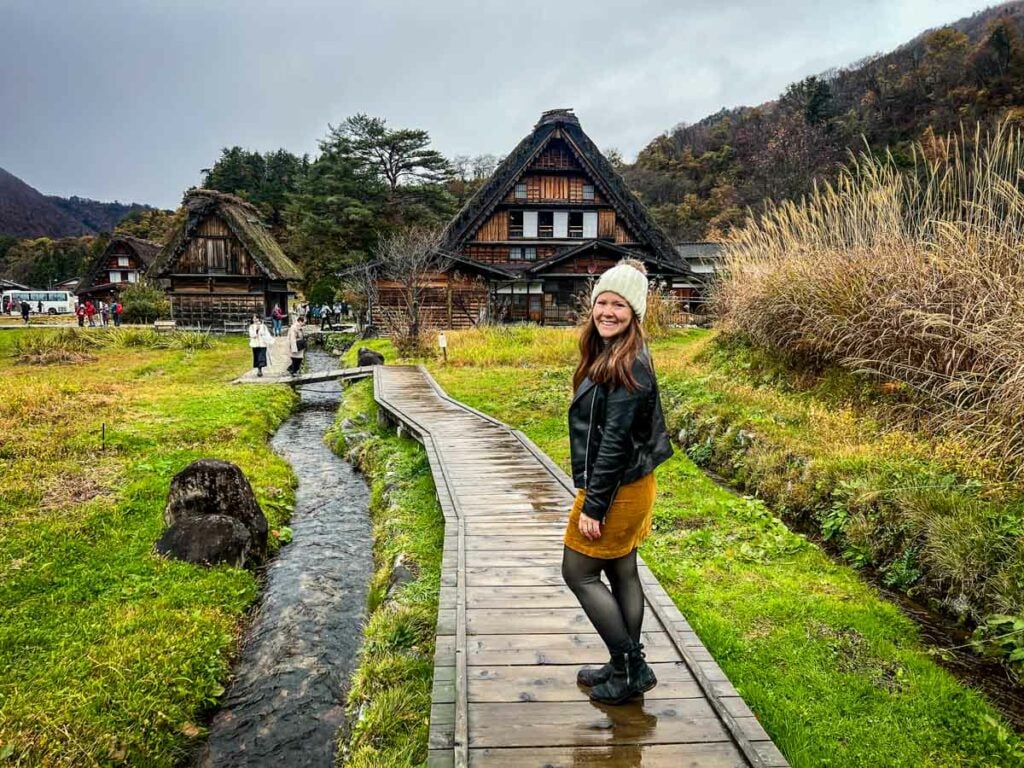
You may have seen the picture-perfect Shirakawa-go on Instagram. I’m pretty sure that’s the first place I ever saw this jaw-dropping Japanese village.
And when I say jaw-dropping I’m not exaggerating. The first time I set eyes on the thatched roof homes set in the Japanese Alps, my mouth hung agape. It’s as if this scene has been plucked straight out of a fairytale or a movie set.
If you’re planning a trip to visit this iconic Japanese landmark, you’re probably wondering if it’s worth the hype (spoiler alert: it is!).
You’re also likely wondering how to get there and what to do once you’ve arrived. And probably a slew of other questions.
Lucky for you, we’ve got all the answers!
We visited Shirakawa-go in the fall and had the best time, so we rounded up all our tips and things we learned so that you can have a wonderful experience.
Let’s dive in and start planning the perfect visit to the villages of Shirakawa-go!
Shirakawa-go Travel Guide
If you know what you’re looking for, click one of the links below to get right to the answers you need. If you’re still in the planning stages of your trip, we recommend scrolling down so you can see all sections, as we have tons of helpful information!
- Overview
- Things to do in Shirakawa-go
- 1 day itinerary
- Where to eat
- Where to stay
- How to get there
- Best time to visit
- Tips for visiting
- Shirakawa-go FAQs
- Places to visit nearby
- What to pack
Shirakawa-go overview
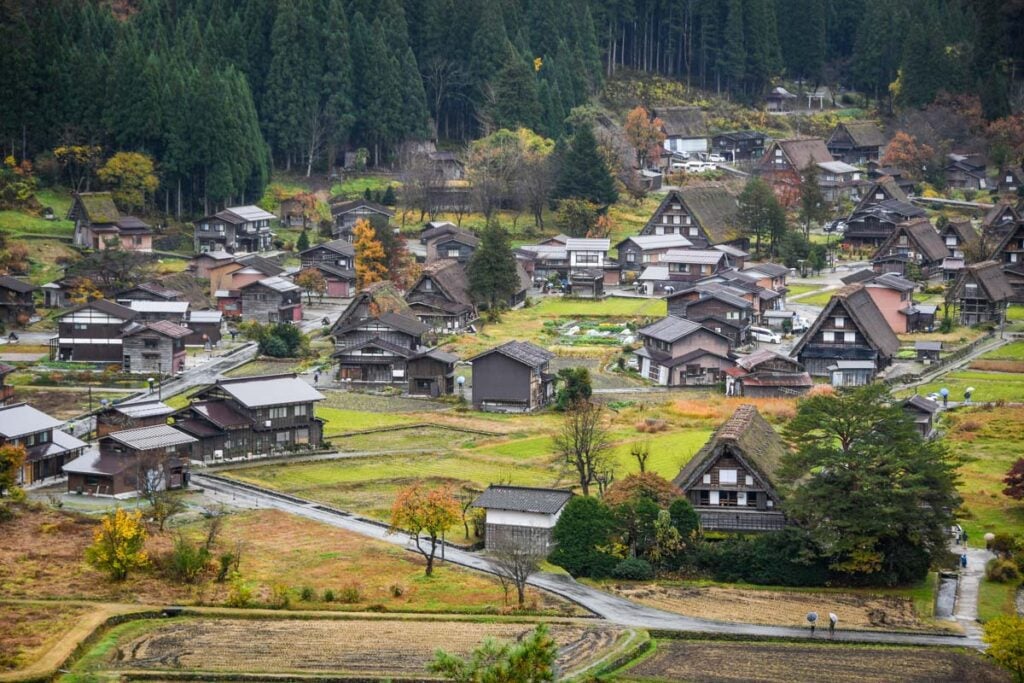
- Location: Google Maps location
- Prefecture: northwest Gifu
- Cost to visit: Free
- Parking: There are a few lots in town that cost a fee (usually around 1,000 yen). However this parking lot is free and where we suggest parking!
- Season: you can visit year round
- Nearest cities:
- Takayama (50 km / 50-minute-drive)
- Kanazawa (75 km / 70-minute-drive)
- Toyama (85 km / 80-minute-drive)
- UNESCO World Heritage site (since 1995)
- Elevation: 7,200 feet / 2,200 meters
Situated high in the Japanese alps in northwest Gifu prefecture, Shirakawa-go is known for its clusters of thatched roof homes nestled in the countryside.
It is one of the most popular traditional Japanese villages to visit, and for good reason. Not only is it stunning, but there is actually quite a bit to do while you’re here.
Shirakawa-go and Gokayama (typically just referred to as Shirakawa-go) actually consists of three distinctly different villages:
Ogimachi

This is the “main village” and as such is the most popular for visitors. It is the most crowded, but it also has the most to see and do.
When most people refer to Shirakawa-go, they are talking about this village alone and may not even know there are two other villages that comprise the area.
Good to know: Most things on our list of “things to do” are in Ogimachi. We’ve included Suganuma and Ainokura at the bottom of the list.
Suganuma
With only 9 of the traditional farmhouses, Suganuma is notably smaller than Ogimachi. For this reason, it tends to be quieter and does not attract the crowds or tour buses of its more popular neighbor.
If you’re looking for great photo spots and the chance to avoid crowds, you may want to check Suganuma out for a short visit.
Ainokura
The most remote of the three villages, Ainokura is kind of like Goldilocks – smaller than Omigachi but bigger than Suganuma. Just right!
Home to roughly 20 farmhouses, Ainokura feels more like a working village than Ogimachi and draws fewer crowds. This is a great place to take your camera out and get shots sans tourists.
Want to see Shirakawa-go right now?! Check out the live cam!
Gassho style farmhouses
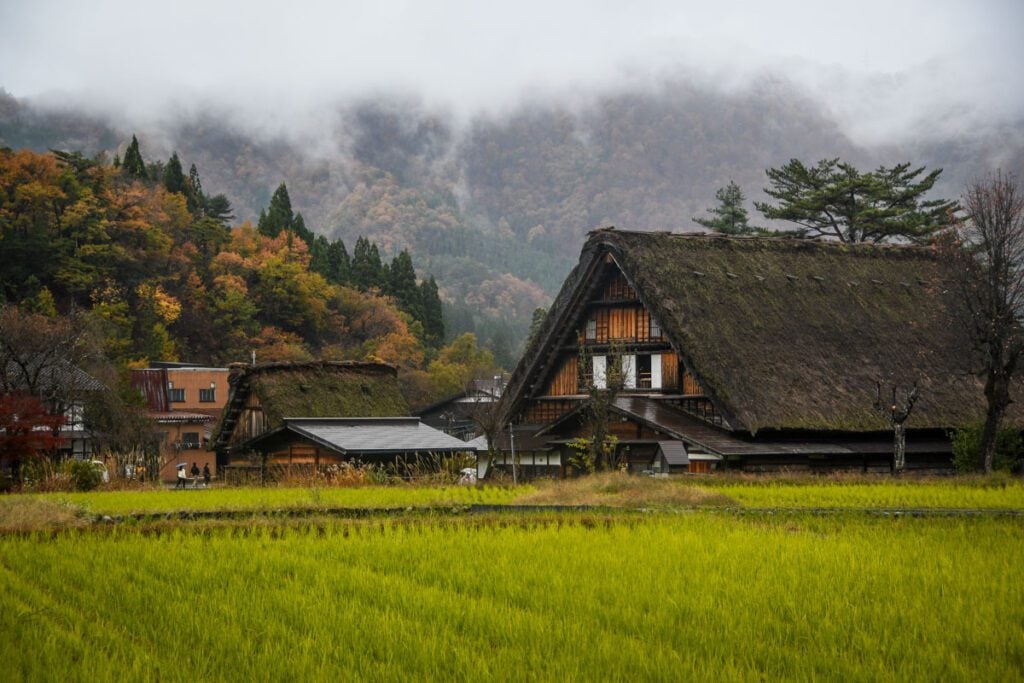
The villages that comprise Shirakawa-go are most well-known for their gassho-zukuri-style farmhouses. In other words, the thatched roof homes you see on Instagram!
In fact, it is this unique architectural style that earned these villages UNESCO World Heritage Status in 1995.
At first glance, you may just think they are beautiful, but a deeper dive into the culture of this region will tell you that these homes were designed in this way for very practical reasons:
- Sloped roofs: The high pitch of the roofs helps them withstand heavy snowfall, for which this region is well-known.
- Large attics: Another notable difference between these gassho style houses and other traditional Japanese homes is that there are large attic spaces. These were originally designed to house and breed silkworms, as silk production was historically one of the largest industries in this region.
- Large space for living and working: These farmhouses were not just homes, but served as workshops as well to allow their residents to continue working through the harsh and snowy winters.
Learn Japanese: The term satoyama can be used to describe a place where nature and humans coexist. It often refers to rural villages surrounded by the natural world (rice fields, mountains, forests, and ponds) and can certainly be used to describe Shirakawa-go.
Things to do in Shirakawa-go
Alright, we’re all in agreement that Shirakawa-go is stunning, right? So what is there to do once you’re there?
Surprisingly, there’s more to do here than I thought!
We’re sharing the best things to do in Shirakawa-go, along with our personal tips.
1. Photograph Ogimachi from above

The village of Ogimachi is stunning, and many of the photos you’ll see online of it are taken from above.
Ogimachi Castle Observation Point is the best (free!) spot to view the town and take photos overlooking all the iconic farmhouses. As the name implies, this was the former site of Ogimachi Castle, and it boasts beautiful panoramic vistas over the village.
This vantage point gives you a unique perspective to capture the traditional thatched roofs as well as the mountains in the distance. When we visited in the peak of autumn, we saw a light dusting of snow on the distant hills and foliage in the foreground, which made for pretty cool photographs.
From this viewpoint, you can follow the path downhill to the village, which will take 10-20 minutes, depending on where you’re going.
For those with mobility issues, there is a shuttle bus that runs from the observatory to the Wada House (in the village) and costs 200 yen per person (pay in cash on the bus). It runs every 20 minutes between 10 a.m. and 2:40 p.m. every day (with an hour-long break from 12 p.m. to 1 p.m.).
Personally, we’d recommend walking if you’re able, as you’ll see more this way and it’s not a long or difficult path.
Insider tip: Being that you will likely go to this viewpoint, we recommend parking here. This lot is free, unlike the lots in town which cost a fee (usually 1,000 yen). Plus, you can start and end your time in Ogimachi with the best view in town and you’ll hopefully catch it with different lighting, making for two distinct photo opportunities.
2. Tour a gassho farmhouse

That’s right – you can actually go inside some of the traditional houses in Ogimachi.
This doesn’t mean you can just step inside any house – some of them are private residences (how embarrassing would that be?!).
However, there are designated farmhouses in Ogimachi that are open to the public to tour.
I will say that while it is neat to see the traditional style architecture, there isn’t much to these “museums” and touring won’t take very long.
Wada House

This is the largest farmhouse in the village and also one of the most significant (designated Important Cultural Property).
The Wada family resided here during the Edo Period (1603-1868). They were traders of silk and gunpowder, as well as the head of the village.

This farmhouse remains a private residence to this day, but visitors can tour the 2nd and 3rd floors during their open hours.
- Hours: 9 a.m. to 5 p.m. daily
- Admission price: ¥300 for adults and ¥150 for children
- Google Maps location
Kanda House
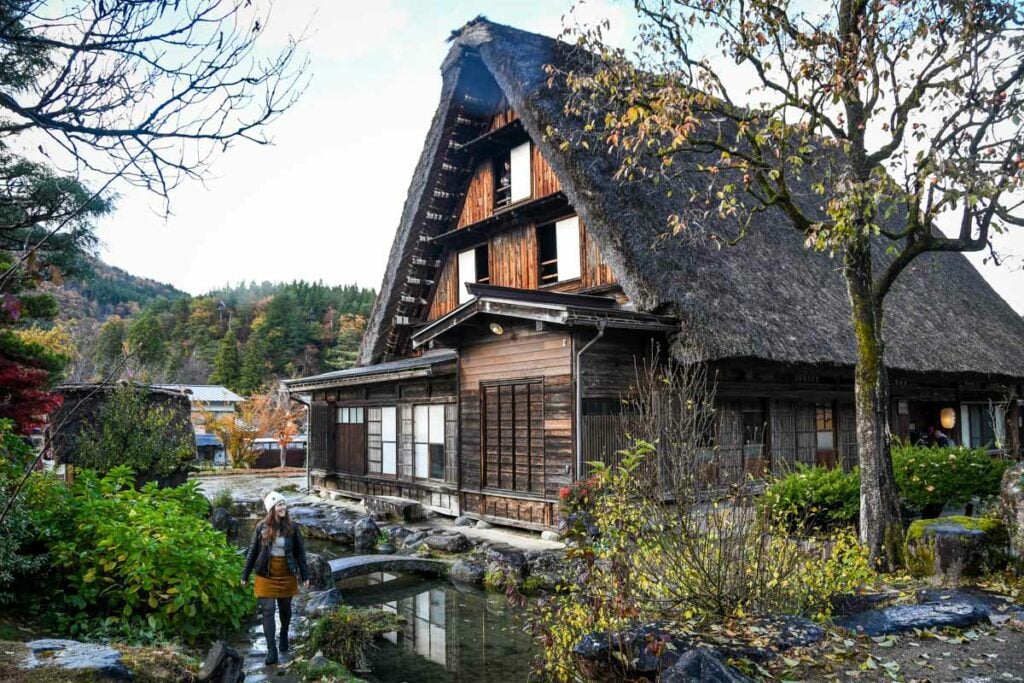
Visitors are welcome to explore this 4-story farmhouse.
- Hours: 9 a.m. to 5 p.m. daily
- Admission price: ¥300 for adults and ¥150 for children
- Google Maps location
Nagase House
At five stories high, this is the tallest farmhouse in Ogimachi.
- Hours: 9 a.m. to 5 p.m. daily
- Admission price: ¥300 for adults and ¥150 for children
- Google Maps location
Our advice: Unless you’re very much into history and traditional architecture, we think visiting one of the farmhouses is sufficient, as they are all pretty similar and each charge admission fees.
3. Cozy up with coffee
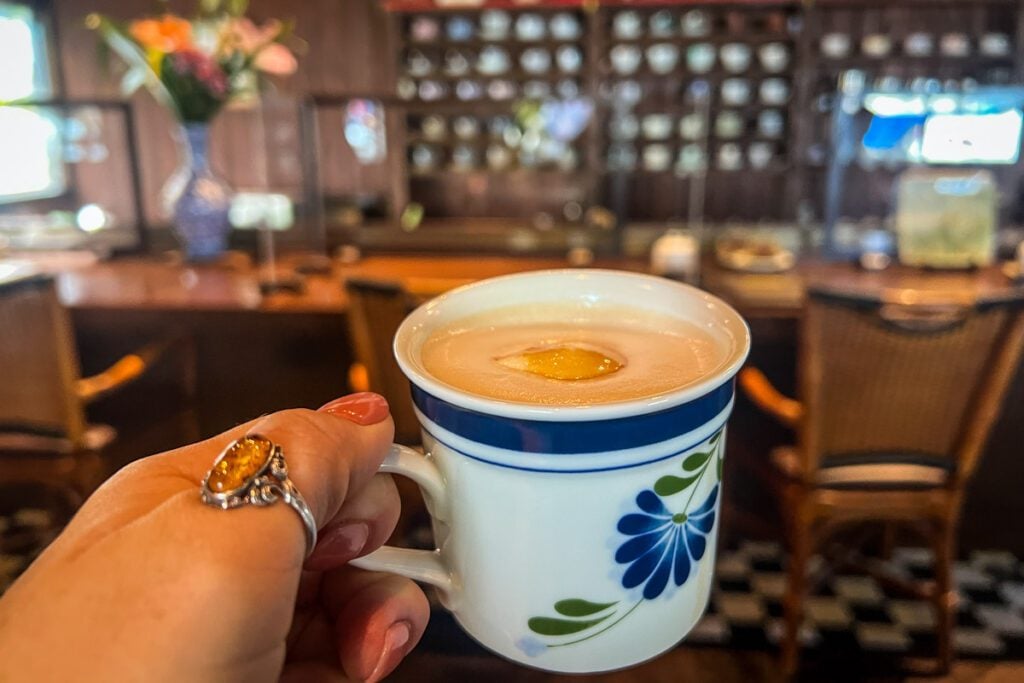
If you need a little pick-me-up or just want to take your time and enjoy your day at a slower pace, there are a few charming coffee houses in the village that make a wonderful place to stop for a cuppa.
- Kyoshu: This would be our top pick, as it has absolutely stunning views of the surrounding rice field and a charming atmosphere. Unfortunately for us, this shop was closed on the day we were visiting.
- Ochiudo: This cozy farmhouse has been converted into a cafe where you can enjoy coffee, tea, or even a simple meal. Beware that it does get extremely busy and there was a long wait when we were visiting.
- Coffee Shop Hina: Located outside the touristic village center, this coffee shop sees far fewer visitors than elsewhere in town, but it is very cute and a good alternative if the others are too busy. The older gentleman who owns this shop is super friendly, and the atmosphere is lovely. They don’t serve coffee to go, but it is a nice place to relax for a bit (maybe with a slice of cake!) without the crowds of the rest of the village.
4. Buy a local souvenir
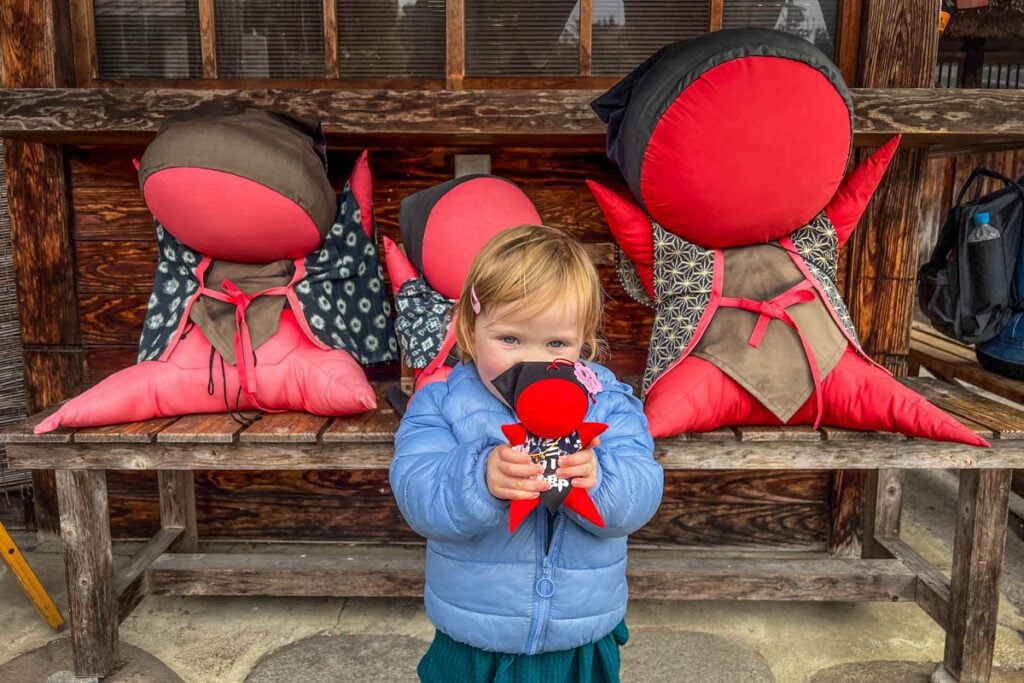
Shirakawa-go is the perfect place to buy a souvenir in Japan as there are a handful of small shops selling local goods that you can’t find elsewhere in the country.
You’ll find local foods and snacks, wooden items, and silk products in the shops around town. But the most interesting item (in my opinion!) that this region is known for is sarubobo dolls.
These dolls are red with a black handkerchief head covering and have no facial features. They are good luck charms and are given for 3 reasons:
- to protect from bad things
- for a happy home and a good partnership
- having an easy childbirth
Sarubobo dolls come in all sizes, from keychains to very large.
When we were wandering around Shirakawa-go, Juniper kept pointing and saying “red baby” which was cute enough to convince us to buy her one!
Good to know: You can also find sarubobo dolls in Takayama.
5. Sample local street food
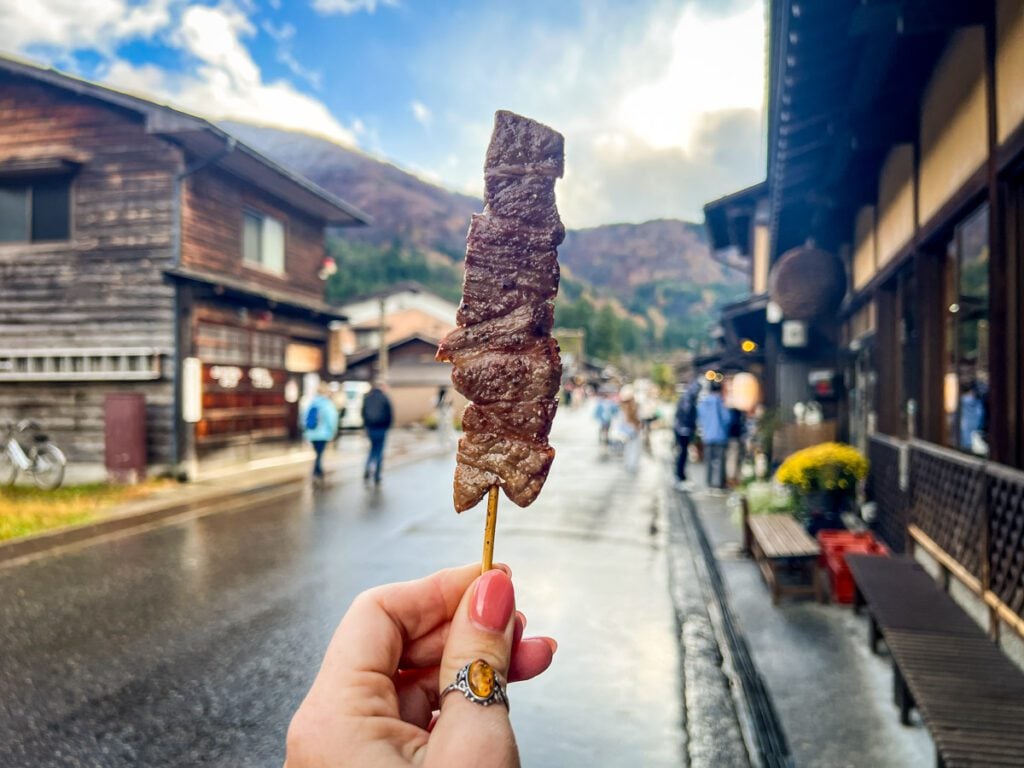
You won’t have to look far to see vendors selling a variety of handheld foods. Sample as many as you have room for!
Hida beef is a regional specialty, and therefore you’ll find many vendors selling it (it’s also a staple on all the restaurant menus in town).
Street foods to try in Shirakawa-go
- Hida beef skewers: high-quality cuts of beef, grilled over charcoal on a skewer
- Beef korokke: this is a Japanese croquette of sorts made with ground beef that has been stuffed inside mashed potato and deep fried.
- Gohei mochi: regional specialty of skewered sticky rice cake coated with a sweet-and-salty glaze of miso, soy sauce, and walnuts, then grilled over charcoal
- Steamed bun: filled with ground Hida beef
Japanese etiquette lesson: In Japan, it is frowned upon to walk while eating. So stop and enjoy your street food at a standstill, then continue on your journey! Read more about Japanese etiquette before your trip!
6. Indulge in award-winning pudding
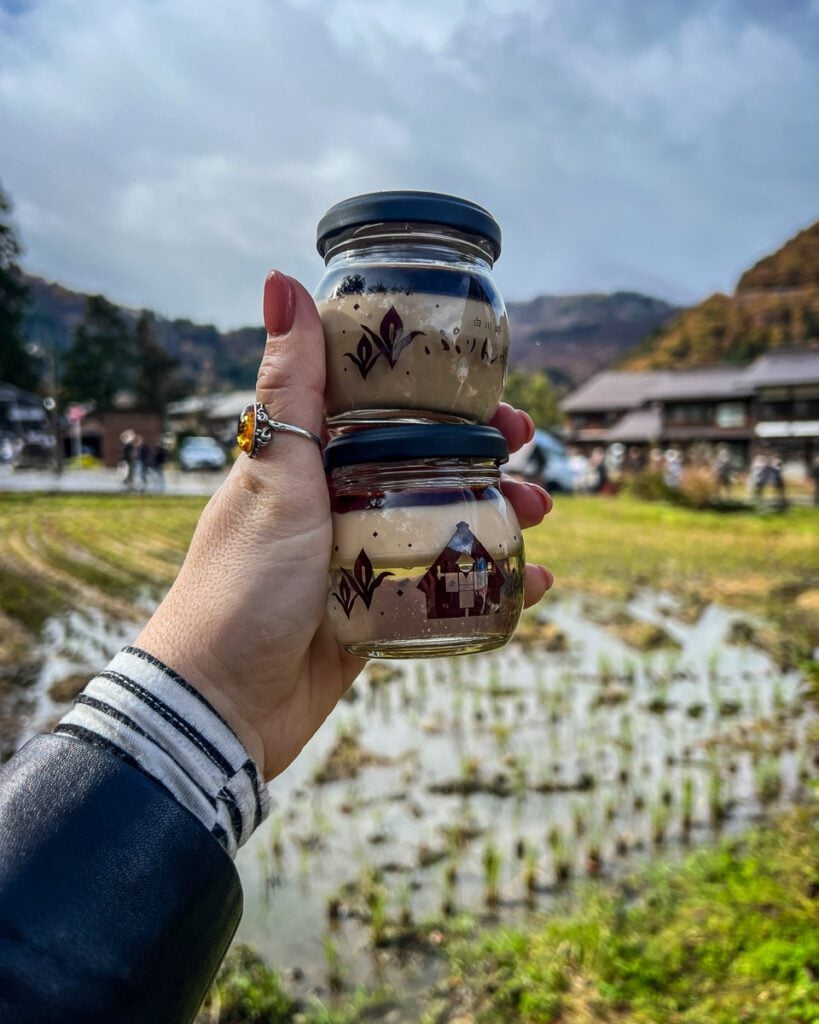
Even if you don’t consider yourself a “pudding person” (yep, me neither), I’d still recommend making a quick stop at Purin no le pudding house when in Shirakawa-go. This tiny shop often has lines, but don’t worry, it moves quickly.
Now, we’re not talking pudding like the ultra sweet chocolate Snack Packs that used to be a school lunch staple. The pudding in Japan is much less sweet, has a firmer texture, and is more akin to creme brulee.
The flavors are all in Japanese, so you’ll either need to whip out your Google Translate app or ask the staff (who speak a bit of English) about their flavors. There’s a pretty good variety, including some seasonal flavors and those that are year round staples.
We asked the friendly woman at the counter which was her favorite, and without hesitation she said “sweet potato”. Not gonna lie, sweet potato didn’t sound that appealing to me but since she had recommended it we got one of those as well as coffee and their signature flavor that had a sign boasting lots of awards.
She was right, the sweet potato was amazing! Don’t hesitate, just order it. The coffee was also very good. Their signature flavor (it had a layer of clear pudding) was just alright in my opinion, and didn’t have as much flavor as the other two.
Insider tip: The pudding comes in small glass jars that you can return to the shop where they have a recycling box, or you can keep them as a souvenir.
7. Have lunch in a farmhouse

One of the best things to do in Shirakawa-go is to have lunch. There are a handful of wonderful restaurants, some of which are situated inside traditional farmhouses.
Most menus highlight Hida beef, which is a regional specialty.
Insider tip: We’d highly recommend making a lunch reservation ahead of time because this is such a small town and without reservations you may be turned away.

Personal experience:
We personally ate at Hiiragi, which is a little outside the main center of the village. We ordered the beef sukiyaki and the Hida beef skewer lunch sets, both of which were great and very reasonably priced at around 2500 yen.
If you go here, make a reservation through their Instagram account. The owner is friendly and very passionate about cars, which you’ll see pictures of hung everywhere in the restaurant.
8. Visit Myozen-ji Temple & Museum

This is another building you can enter, and it’s the largest in the village. The designated Important Cultural Property is made up of a main hall and kuri (monk’s residence) which now houses a museum showcasing traditional life in Shirakawa-go.
In front of Myozen-ji stands the Shoroman Gate, a bell tower with a thatched roof. The gate is flanked by a 200-year-old yew tree and a cherry tree.
Hours:
- 8:30 a.m. to 5 p.m. (April – November)
- 9 a.m. to 4 p.m. (December – March)
Admission:
- Adults: ¥400
- Children: ¥200
Good to know: This has a similar feel to the farmhouses you can tour (#2 on this list). Unless you’re a huge history or traditional architecture buff, we think you’d be fine choosing just one building to tour.
9. Find the best photo spots in town

Wandering the paths and getting a bit lost is part of the fun of exploring Shirakawa-go.
The village is very small so you’ll never be too far off the main road, but walking the small streets and getting up close to the traditional buildings is very cool.
Play around with different angles and shots, as this village has some incredible photo opportunities.
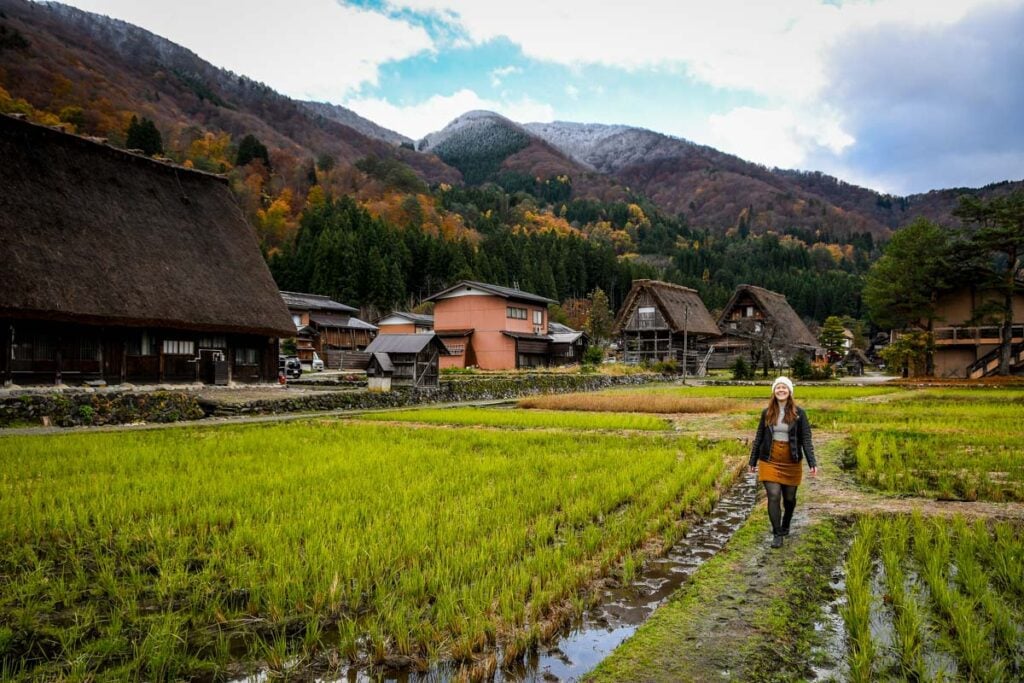
While we already shared that Ogimachi Castle Observation Deck has the best view overlooking town, here are some spots in the village to aim for if you want some more good photo ops:
- Three Houses Viewpoint: Nice vantage point of traditional gassho style farmhouses
- Ogimachi Suspension Bridge: Nice view of the river and the town’s suspension bridge
- Gassho-zukuri Minkaen: Open air museum on the opposite side of the river from the main part of town. This features a water mill, traditional farmhouses, and a cafe. It costs a small fee to enter this area.
10. Soak in the village onsen

If you’re visiting on a rainy day or in the wintertime, you may want to pop into the village onsen to warm your bones after walking around town.
You can visit even if you’re not staying at the onsite hotel.
Good to know: I read in one review that they do not allow visitors with tattoos (though their website does not confirm it), so keep this in mind if it applies to you.
Important information:
- Adults: ¥800
- Children 6+: ¥400
- Children 5 and under: free
- Towel rental:¥300
- Hours: 7 a.m. to 9 p.m. daily (last entry at 8:30 p.m.)
- Google Maps location
11. Visit Shirakawa Hachiman Shrine
Believed to have been founded between 708 and 715, this Shinto shrine is just a short walk from the main street but doesn’t get as many visitors as some of the other attractions in the village.
The wide stone steps, weathered torii gate, and surrounding forest make for a picturesque setting. The site is also known for a cedar tree believed to be 200-300 years old that locals consider a natural treasure.
In October, Shirakawa Hachiman Shrine hosts a festival where offerings of Doburoku (a type of sake) are given in hopes of peace.
12. Visit Shiramizuno Falls
This breathtaking waterfall in Hakusan National Park plunges straight down over a rough cliff face into a turquoise pool surrounded by lush greenery. In autumn, the surrounding forest becomes a vibrant tapestry of reds, yellows, oranges, and evergreens.
According to Google Maps, it’s a 36-minute drive from Shirakawa-go, but reviews also say the road is narrow and it’s difficult to see oncoming traffic, so use extra caution if you’re driving this route.
13. Marvel at Ubagataki Falls and soak in the onsen
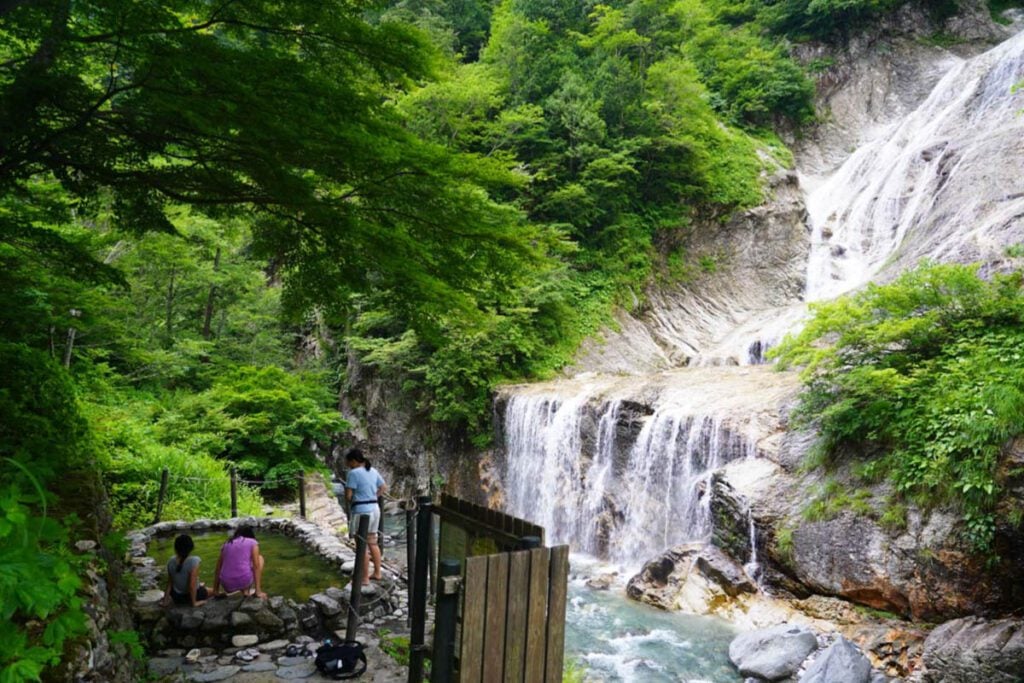
Speaking of waterfalls, this one looks absolutely dreamy! It sort of reminds me of the iconic “sticky waterfall” near Chiang Mai, which is one of my favorites.
This waterfall is quite off the beaten track, so it doesn’t tend to get very crowded. Getting to Ubagataki Falls is roughly a 1-hour drive from Shirakawa-go, on a road that is said to be one of the most scenic drives in Japan. (You should only plan to go here if you are renting a car.)
The waterfall itself is stunning, but the best part (in my opinion) is the onsen, or hot soaking pool, at its base.
Once I saw a photo of Ubagataki Falls and its onsen, I knew we needed to include this in our day trip to Shirakawa-go, but there was one major problem…
The road to get here closes down each year in the fall in preparation for the winter season, as this area gets lots of snow. Unfortunately for us, the road closed mere days before our visit, so we couldn’t go. I may have shed a tear.
If you are visiting in the late spring, summer, or early fall and are driving yourself, please get to this waterfall so I can live vicariously through you! (And send me a picture!)
How to get there: Here is the Google Maps location that you’ll drive to. Remember, you will not be able to get here in the late fall and winter seasons. From the parking lot, go down the steep set of stairs that will bring you to a path. Walk on this for about 10 minutes until you reach the waterfall and soaking pool. Check out this guide to Ubagataki Falls for all the details you’ll need.
14. Visit the “other” villages
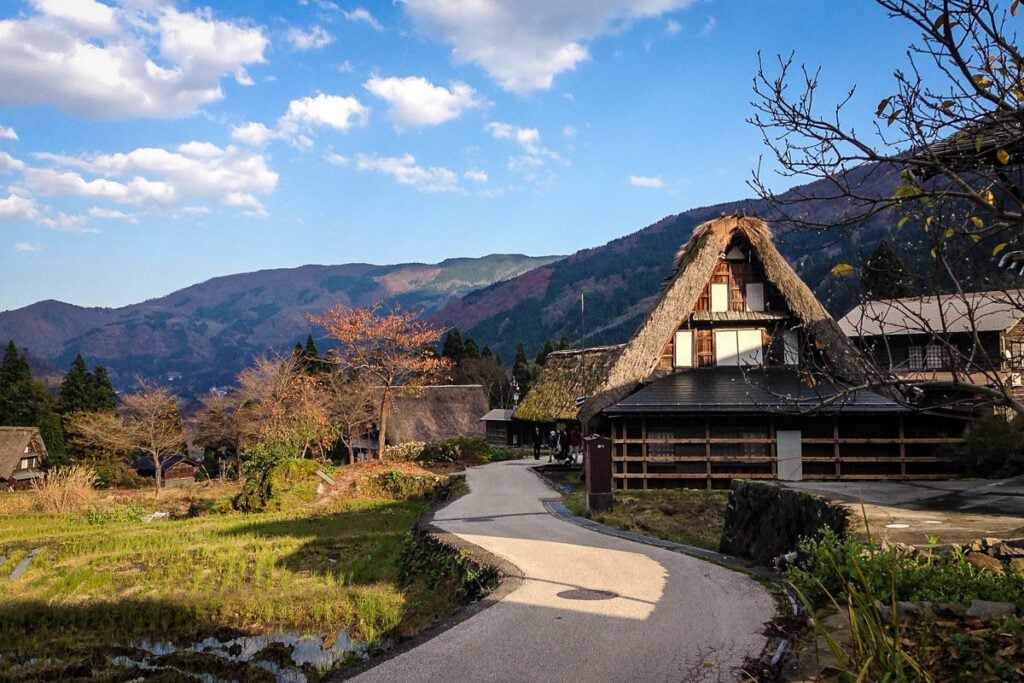
While Ogimachi is undoubtedly the most famous part of Shirakawa-go and the village most people visit, there are two other villages that technically are also part of it as well.
If you have the time and are self driving, include a stop at the other two villages to get an experience that most visitors skip.
One thing to note is that the other two villages are quite a drive from Ogimachi, so you’ll need to plan your day accordingly. Suganuma is on the way to Ainokura.
- Ogimachi to Suganuma: 25 minutes (with tolls) or 30 minutes (without tolls)
- Suganuma to Ainokura: 8 minutes
Good to know: If you are staying in Kanazawa, Suganuma and Ainokura won’t be too far out of the way and would be easy to tack on. However, if you’re staying in or around Takayama (like we were), it will add an additional 1.5 hours of driving round trip.
Suganuma
With only 9 of the traditional farmhouses, Suganuma is notably smaller than Ogimachi. For this reason, it tends to be quieter and does not attract the crowds or tour buses of its more popular neighbor.
If you’re looking for great photo spots and the chance to avoid crowds, you may want to check Suganuma out for a short visit.
Ainokura
The most remote of the three villages, Ainokura is kind of like Goldilocks – smaller than Omigachi but bigger than Suganuma. Just right!
Home to roughly 20 farmhouses, Airnokura feels more like a working village than Ogimachi and draws fewer crowds. This is a great place to take your camera out and get shots sans tourists.
Personal experience: I really wanted to visit Ainokura and planned to make a quick stop in Suganuma since it’s on the way. However, we didn’t want to rush ourselves in Ogimachi and by the time we were ready to leave, we didn’t have enough daylight for the other villages. Womp womp. If you do get to visit the other two, we’d love to hear your thoughts!
Why not stay in Ainokura? The accommodation here is far less expensive than in Ogimachi, and it is more peaceful.
- Minshuku Goyomon: traditional style accommodation that serves dinner and breakfast, earns rave reviews, and is reasonably priced for what you get.
- Gokayama Base: this accommodation is modern and clean, very budget friendly, and earns excellent reviews
15. Stay in a traditional farmhouse
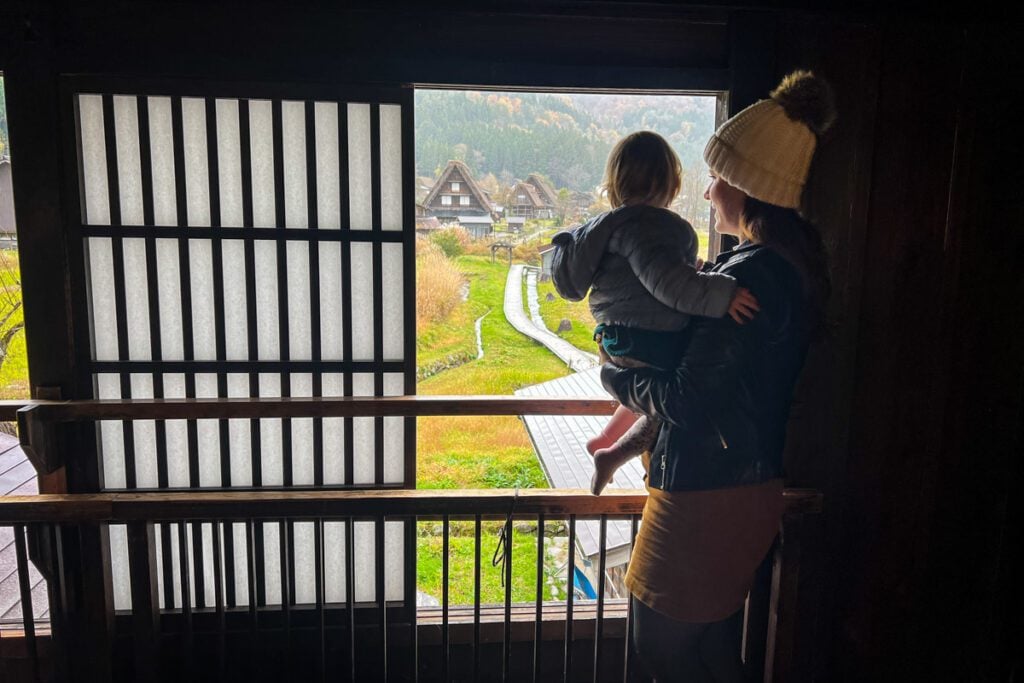
While you can tour the traditional farmhouses, this region is a great place to actually stay in one. It is such a unique experience that you can’t have just anywhere, and it will surely be a highlight of your trip to Japan.
While there are a handful of farmhouses that have been converted into accommodation, they are popular and book up well in advance.
You won’t find any of these listed on Booking.com (at least not yet!), and booking them requires a bit of effort. You can check this website to inquire about booking a farmstay in Shirakawa-go.
Alternatively, if you’re not tied to staying in Shirakawa-go, but would like to experience staying in a traditional style Japanese home, we’d highly recommend Tanekura Inn. (pictured below)
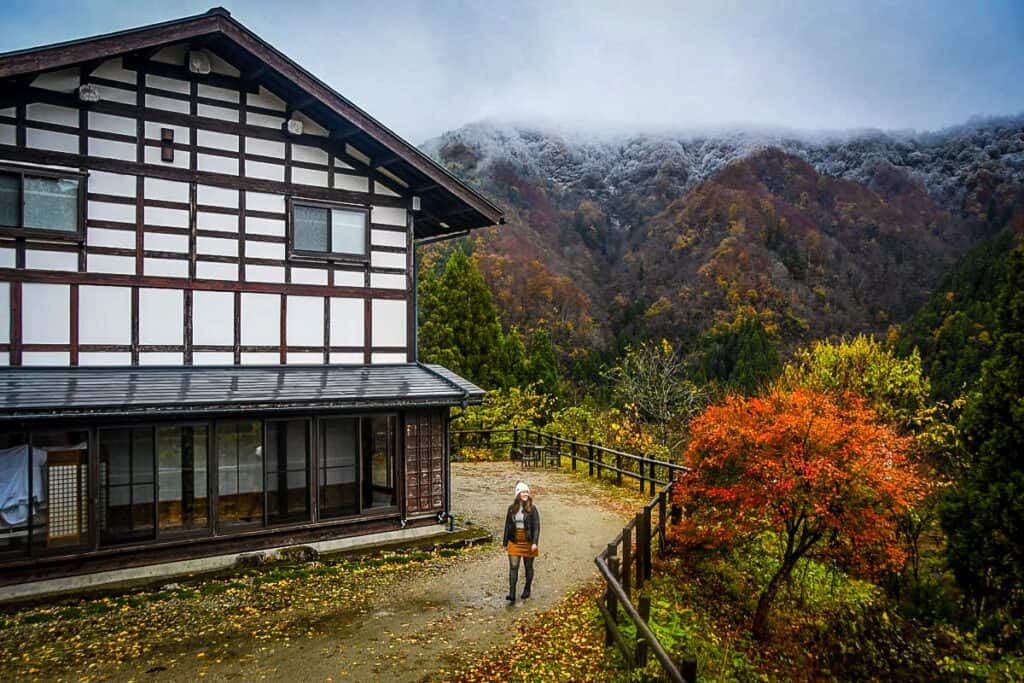
We stayed in this lovely Airbnb in the countryside just outside Takayama and had a wonderful experience.
The sweet host cooked us a meal over the traditional fireplace and we did a soba noodle making class. We used Tanekura Inn as our base for exploring both Takayama and Shirakawa-go as day trips.
1 day in Shirakawa-go itinerary
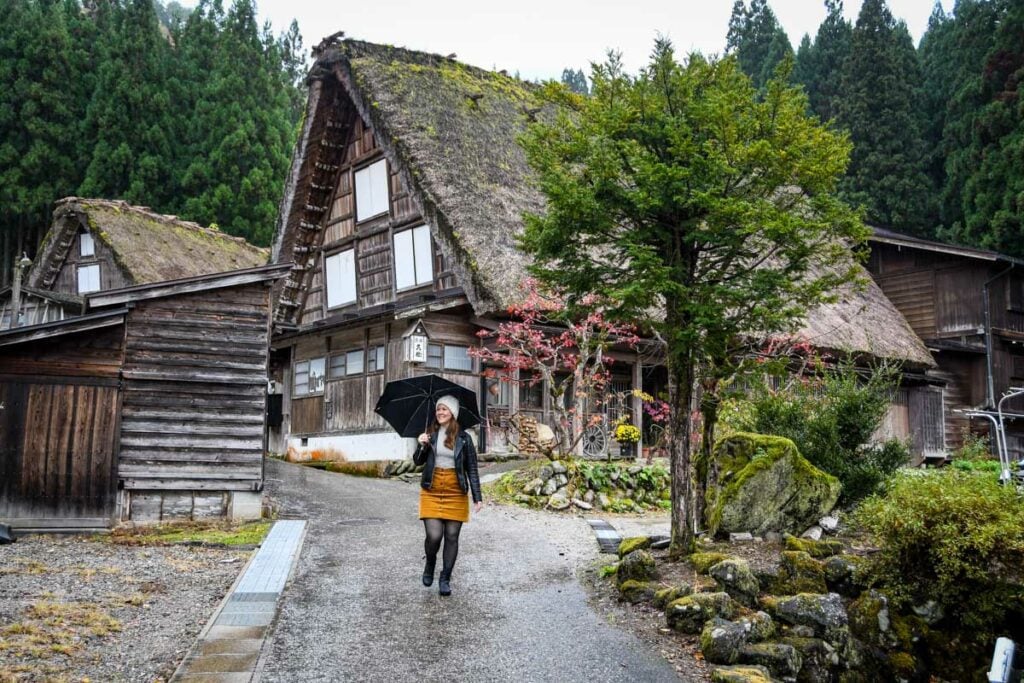
Want your day planned for you? We’ve got you covered:
- Park here as it is free and the best viewpoint overlooking the village
- After taking photos from above, follow the path and walk into the village (10-20 minutes)
- Have coffee at Kyoshu or Ochiudo
- Wander the streets and take photos
- Have lunch
- Get pudding at Purin no le
- Tour a farmhouse
- Shop for souvenirs
- Try some street food
If you have more time:
- Visit the other villages, OR…
- Go to a waterfall
Read through our whole list of things to do and add in anything else that strikes your fancy!
Where to eat in Shirakawa-go

For a small village there are quite a few options of places to eat. That said, since there are many visitors each day, you may find yourself waiting. We’d recommend making reservations if possible.
- Hiiragi: a bit outside the village, the meal sets are delicious and reasonably priced
- Make reservations by messaging them on Instagram
- Ochiudo: curry rice bowl in a farmhouse with a traditional fire cooking pit
- China beef or wild vegetable udon
- Shirakawago Restaurant Irori: regional dishes with vegetarian options in the center of the village
Where to stay in Shirakawa-go
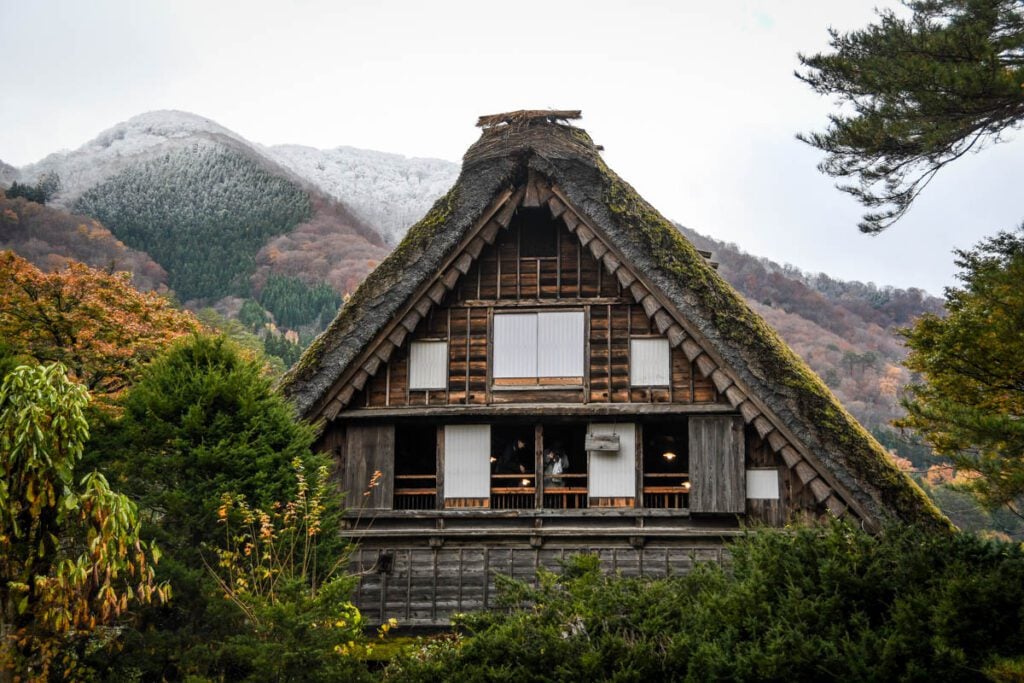
You can certainly visit Shirakawa-go as a day trip (that’s what most people do!), but if you’d like to go at a slower pace and not feel rushed, you may be curious about staying overnight.
There are a few different options for accommodation in the villages themselves and nearby Shirakawa-go.
Stay in Ogimachi
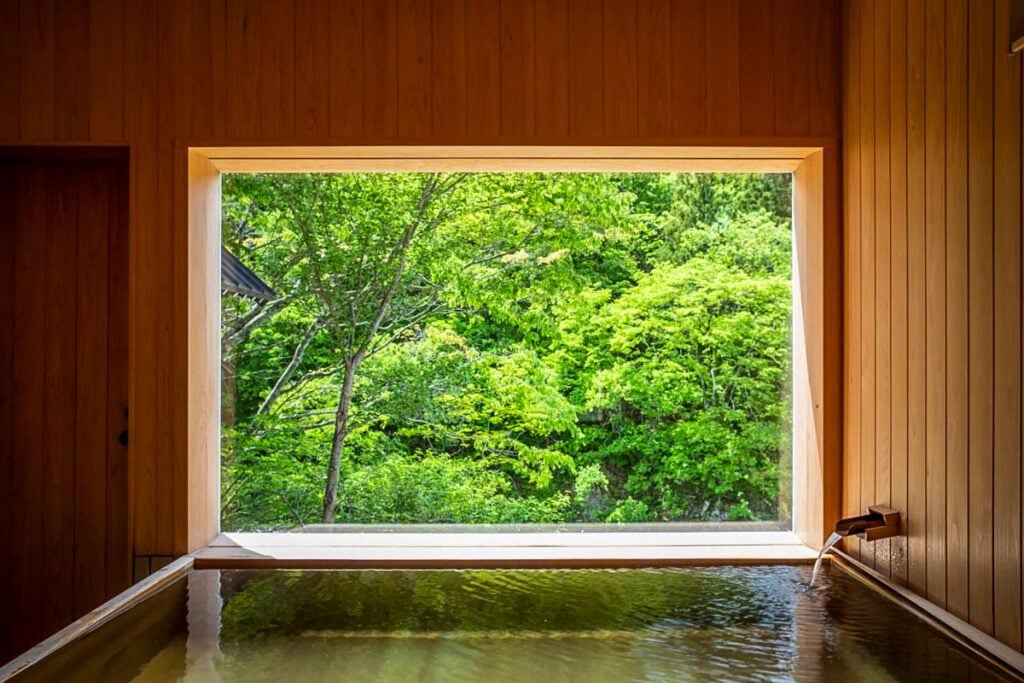
Staying right in the main village of Shirakawa-go would allow you to have some quiet time before all the day trippers arrive.
- Shiroyamakan: arguably the best accommodation in Shirakawa-go with exceptional dining and an overall incredible experience, this is a splurge stay but guests rave about it. Book in advance because it sells out.
- Onyado Yuinosho: Ryokan style accommodation just north of Ogimachi village
- Guesthouse Shirakawa-go Inn: The only budget accommodation in Shirakawa-go. The rooms are very basic, but the location is great.
- Way Shirakawa-go: Apartment-style accommodation very close to the village
Alternative: You can check this website to inquire about booking a farmstay in Shirakawa-go.
Stay in Ainokura
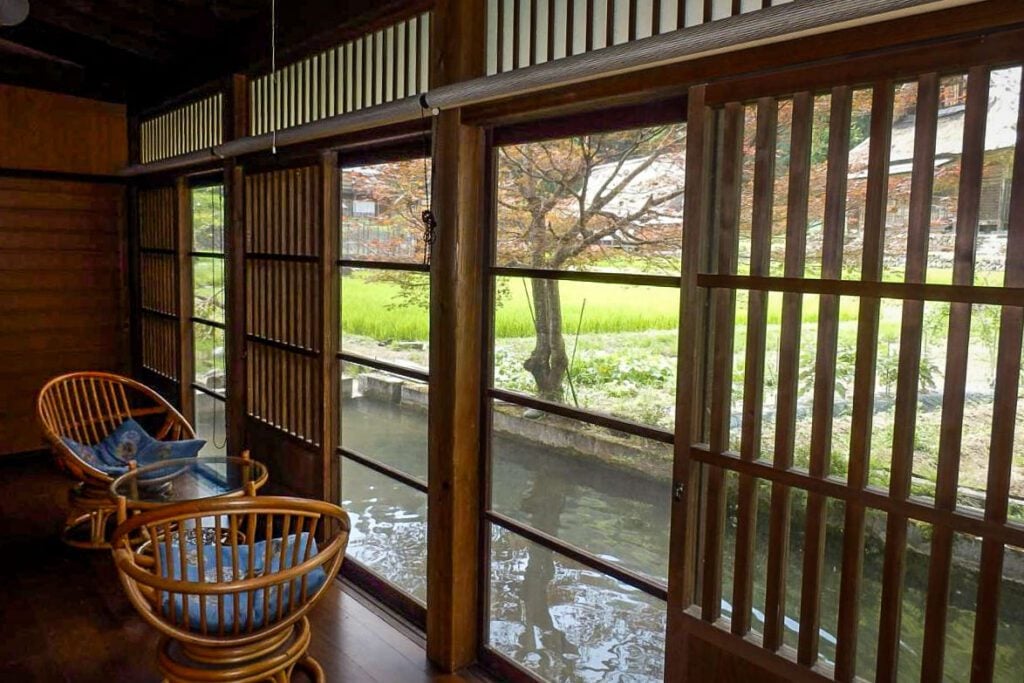
The accommodation in this Shirakawa-go village is far less expensive than in Ogimachi, and it is more peaceful.
- Minshuku Goyomon: traditional style accommodation that serves dinner and breakfast, earns rave reviews, and is reasonably priced for what you get.
- Gokayama Base: this accommodation is modern and clean, very budget friendly, and earns excellent reviews.

Alternative: If you’re not tied to staying in Shirakawa-go, but would like to experience staying in a traditional style Japanese home, we’d recommend Tanekura Inn. We stayed in this lovely Airbnb in the countryside and had a wonderful experience. The sweet host cooked us a meal over the traditional fireplace and we did a soba noodle making class. From here, we visited Shirakawa-go as a day trip.
Stay in Takayama

Just a 45-minute drive by car, Takayama is incredibly charming and has a lot to see and do. Plus, there’s a lot of great accommodations to choose from.
- Auberge Hidanomori (our top pick): We personally stayed here and loved it! (pictured above)
- Takayama Ouan: The rooftop onsen here is reason enough to stay
- Wat Hotel & Spa: This is a great budget-friendly pick
- Countryside Airbnb: This cottage in the countryside just outside of Takayama looks stunning and luxurious. We almost stayed here but opted for a more unique stay at this traditional Japanese home.
Stay in Kanazawa
At just over an hour by car from Shirakawa-go, Kanazawa is an interesting mid-sized city on the ocean.
- The Square Hotel: We personally stayed here and think it is a great budget pick
- UAN Kanazawa: Beautiful blend of Western comforts and Japanese style with a great location and reasonable rates
Personal Note: You can also stay in Toyama, but we’d suggest Takayama or Kanazawa instead as they are closer to Shirakawa-go and have more things to do (we’ve personally stayed in all three).
How to get to Shirakawa-go
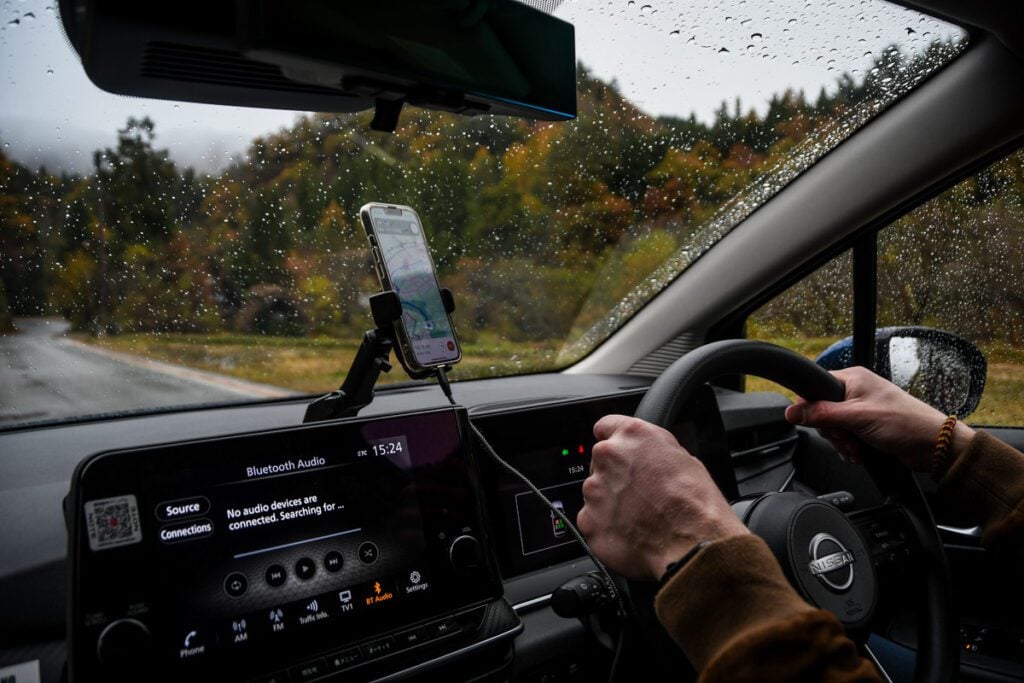
The easiest way to get to Shirakawa-go is by driving. It is pretty straightforward to get here in a car.
Below are the approximate driving times from the three nearby cities to Shirakawa-go’s main village of Ogimachi.
- Takayama to Ogimachi: 45 minutes
- Kanazawa to Ogimachi: 1 hour, 5 minutes
- Toyama to Ogimachi: 1 hour, 20 minutes
Good to know: If you are coming from Takayama, you will drive through a tunnel that is 11 km (7 miles) long, which feels like it goes on forever!
Once you get close to the village, there will be crossing guards that direct you to a parking lot, as vehicles are not allowed to enter the village. Most parking lots closest to the village cost about 1000 yen. We’d recommend going straight to this parking lot (which is free).
→Psst! We have a guide to renting a car in Japan (packed with lots of driving tips you won’t want to miss!).
Getting to Shirakawa-go via bus

However, if you are not renting a car in Japan, no worries. You can still visit Shirakawa-go* using public transportation.
Trains do not come here, but you can catch a bus in the following cities:
From Takayama
An express bus runs from Takayama Nohi Bus Center to Shirakawa-go Bus Terminal. It takes about 50 minutes and costs ¥2,600.
From Kanazawa
The express bus from Kanazawa Station (West Gate) to Shirakawa-go takes around 1 hour and 20 minutes and costs ¥2,600.
From Toyama
Catch the express bus at Toyama Eki mae to Shirakawa-go (1 hour 20 minutes, ¥2,400).
*When saying “Shirakawa-go”, we are referring to the village of Ogimachi.
Guided day trip to Shirakawa-go
If you aren’t into the idea of navigating the buses yourself and you’d like a tour guide, it is possible to do a guided day trip to Shirakawa-go.
This tour starts and ends in Takayama and has great reviews.
Best time to visit Shirakawa-go

Shirakawa-go makes a great year round destination, and each season has its draws.
We personally visited in the fall and loved seeing the village surrounded by colorful foliage, but the winter looks absolutely lovely as well.
→ Psst! We have an entire guide to the best time to visit Japan, so if you’re still in the planning phase of your trip, be sure to check that out!
Shirakawa-go in the spring

Comfortable temperatures and a handful of blossoming trees make spring a great time of year to visit this village.
Good to know: There aren’t all that many flowering trees in the village so keep this in mind if you’re specifically looking for cherry blossom photo spots. Here’s more tips on visiting Japan in the spring.
Shirakawa-go in the summer
With longer daylight hours, the summer can be a great time to pack your days full with lots of exploring before the sun sets.
The drawback to this season is that it can get incredibly hot and humid. Dress with this in mind.
Visiting in summer? Check out our guide to Japan in the summer.
Shirakawa-go in the fall

We visited Shirakawa-go in autumn, and flanked by orange and gold mountains, it was stunning.
The colorful foliage gave the village a warm, moody vibe.
It was rainy when we visited, but with the right shoes and an umbrella, we still had a wonderful time.
Visiting in autumn? Check out our guide to Japan in the fall.
Shirakawa-go in the winter
This looks like perhaps the most beautiful time to visit Shirakawa-go (in my opinion!).
This region of the Japanese Alps is known for getting massive amounts of powdery snow, creating a magical winter wonderland!
The most notable event in the wintertime is the winter light up, during which the farmhouses are illuminated during Sunday evenings of some weekends in January and February. Check this link for the dates and important information for visiting.
→ Visiting in winter? Check out our guide to Japan in the winter.
Tips for visiting Shirakawa-go

After visiting Shirakwago ourselves, we want to share our top tips with you so you have the best experience possible.
1. Get off the main walking street
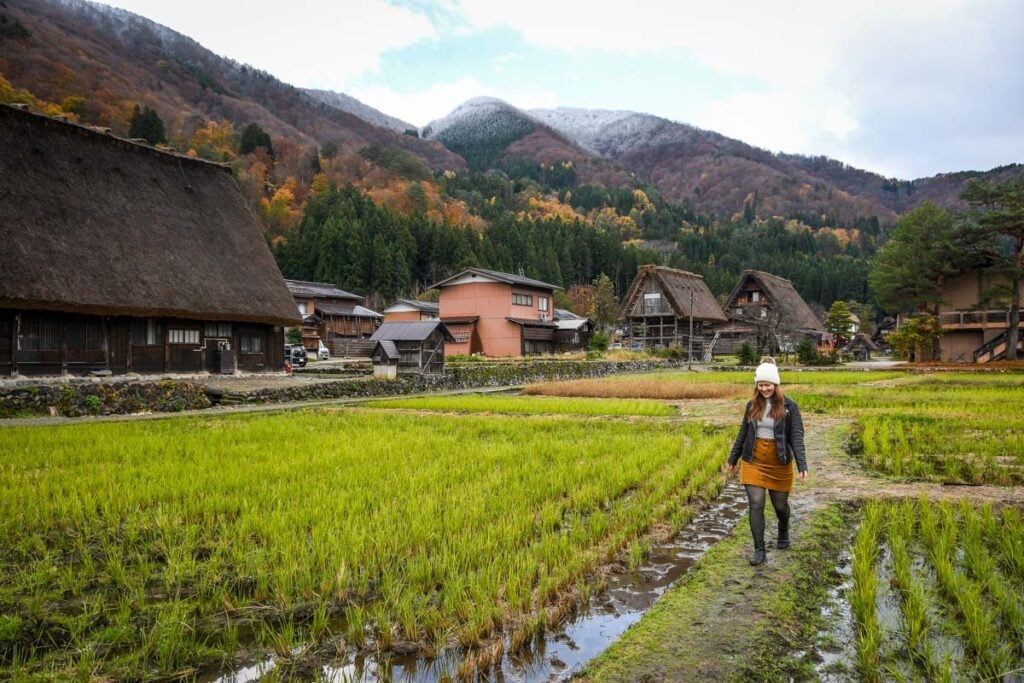
Even just walking a few minutes off the main drag will lead you to much quieter, more peaceful vistas.
2. Decide your route ahead of time
It can be easy to miss some of the best spots in town, so have an idea of the route you’ll take before you go. (Jump here for our recommended route!)
All this said, if you see a cool hidden street, by all means take it and get a little lost!
3. Make lunch reservations
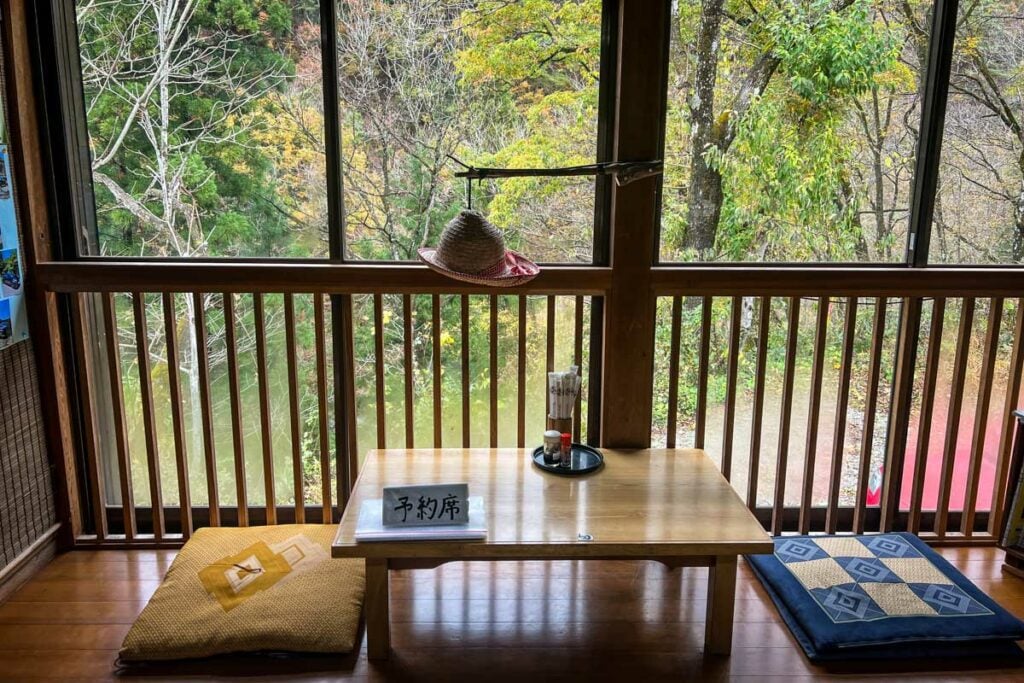
Often, I feel like I only need to make reservations in big, busy cities. But I’d suggest making lunch reservations for your time in Shirakawa-go as well because many of the restaurants get very busy and they don’t have that much space.
If you’re a last-minute traveler, don’t worry. There are stands selling street food, so in a pinch you can always get a bunch of snacks for lunch!
4. Come early
If possible, get to Shirakawa-go early, as it gets more and more crowded as the day goes on.
You could also stay later than most other day trippers, but this might mean driving in the dark or having trouble getting a bus back to your accommodation.
5. Don’t let bad weather deter you

We visited on a rather rainy fall day, and I was thinking about skipping it altogether.
The rain came and went all day, but the village was beautiful even in the gloom. In fact, when the sun came out I realized I actually preferred my photos taken in the clouds and rain.
6. Bring layers
Speaking of weather, bring plenty of layers, sun protection, an umbrella, and anything else you think you’ll need. Other than restaurants and a few shops, there aren’t many places to hang out indoors.
Since you’ll be spending most of your time outside, make sure you’re prepared for all weather.
7. Wear comfortable shoes
You’ll be doing lots of walking in Shirakawa-go, so be sure you’re wearing shoes that’ll be comfortable.
Shirakawa-go FAQs

Still have questions about planning a visit to Shirakawa-go? We’ve got answers!
How much time do I need?
You can see Shirakawa-go in half a day, but I’d recommend setting aside the entire day so you have plenty of time to get there and you don’t feel rushed.
You could also get up to the other 2 villages that make up Shirakawa-go or see one of the nearby waterfalls.
Is Shirakawa-go crowded?
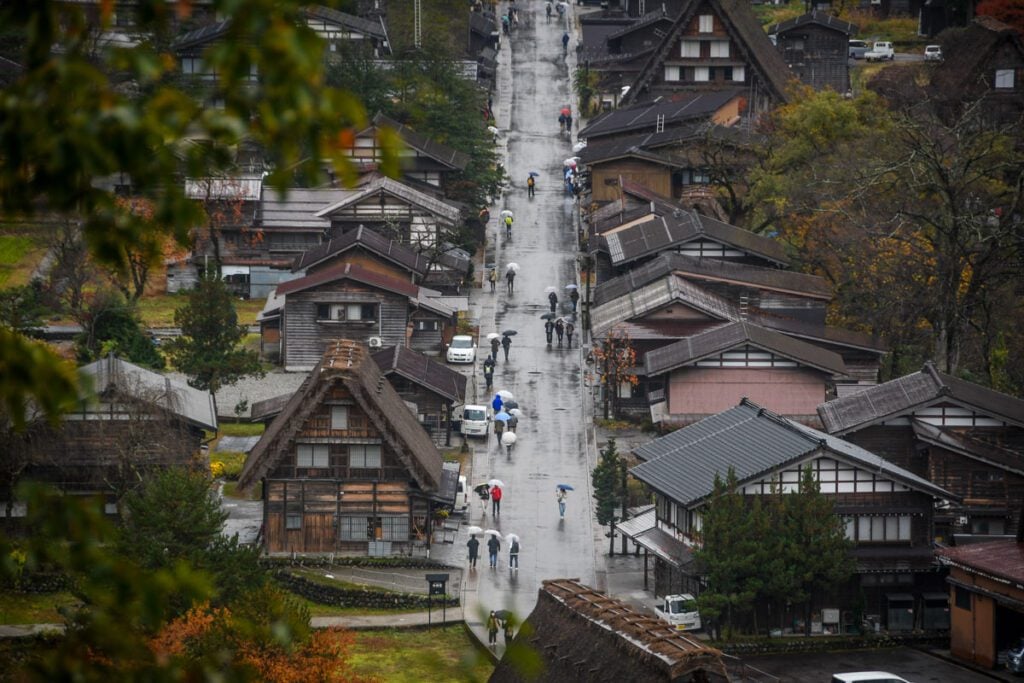
Yes. There’s no sugar-coating it, Shirakawa-go is a popular tourist spot and it does get busy.
That said, it wasn’t nearly as crowded as I was expecting. We went on a rainy day in the fall, so perhaps the weather kept some people away, but it really didn’t feel overbearingly crowded, like parts of Kyoto.
On a sunny day or during festivals, this may be different.
It is somewhat challenging to get to if you don’t have a rental car, so it won’t be as crowded as more easily accessible spots.
The main walking street and popular photo spots tend to have the most people congregating, but if you walk off the main paths, you can definitely get away from the crowds.
Is visiting Shirakawa-go worth it?

It took us 3 trips to Japan to finally make it here, and I can wholeheartedly say it was worth it. (As long as you know what to expect and how to plan your time!)
I’ll be honest, the reason we avoided it on our first two trips is that I worried it would be a tourist trap. Crowded and just a photo spot.
I’ve learned over the years that this isn’t my type of travel. And I just assumed that Shirakawa-go, while stunning, was overhyped.
But we really enjoyed our time there and would recommend visiting if you have the time.
Just keep in mind that it gets busy (especially around midday), and it can be a bit of a hassle to get there if you don’t have a car of your own. I think we liked it so much because we were able to get there early and explore at our own pace without worrying about catching transportation back.
FYI We have a guide to driving in Japan if you are interested in checking it out! You could even rent a car for just a couple of days out of Kanazawa or Takayama to explore this region (where the driving is pretty easy and the countryside is beautiful).
Places to visit near Shirakawa-go

Shirakawa-go is somewhat remote and while definitely worth seeing, we wouldn’t recommend coming to this region only to see this village.
There is so much more to do and see in this general area! Here are some of our personal favorites:
Kanazawa
Known for seafood and immaculate Japanese gardens, this is a fun oceanside city to add to your Japan itinerary.
Takayama

With a charming historic old town and excellent dining options, we love Takayama!
Toyama
This is a nearby seaside city that you may pass through on your way to Shirakawa-go. If you are looking for a good place to base yourself, we personally prefer both Kanazawa and Takayama over Toyama.
Kamikochi
This national park is stunning and a haven for hikers. Discover mountain vistas and a tranquil river valley.
Nagano
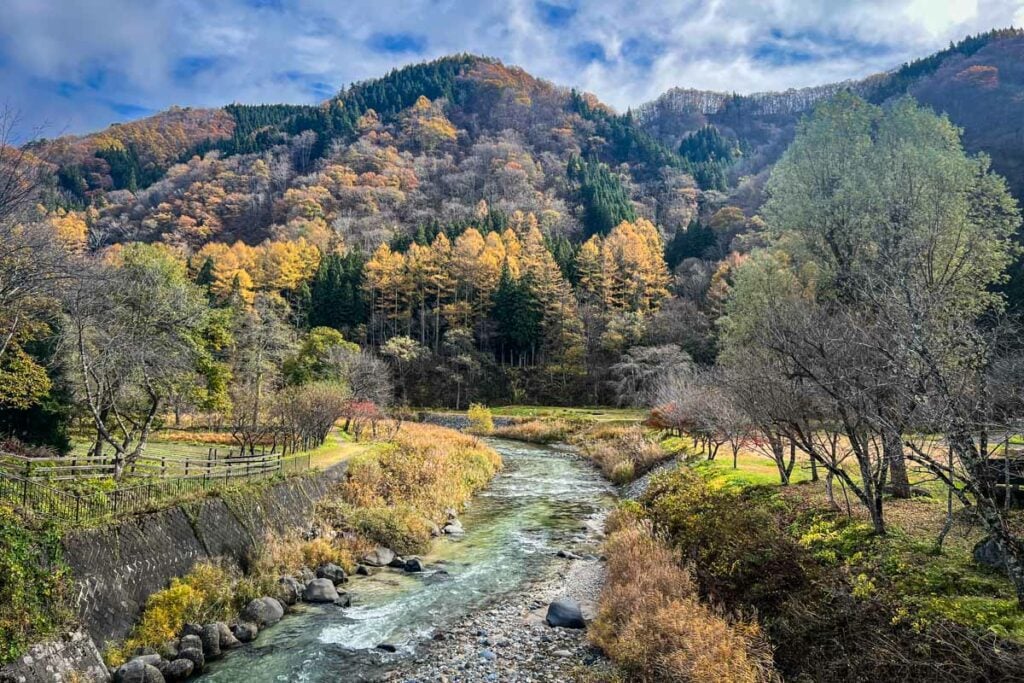
While not next door by any means, Nagano is a good next stop (or previous stop!) on your itinerary. We love this area of Japan because it is a wonderful place to experience nature and tranquility.
Alpine Route
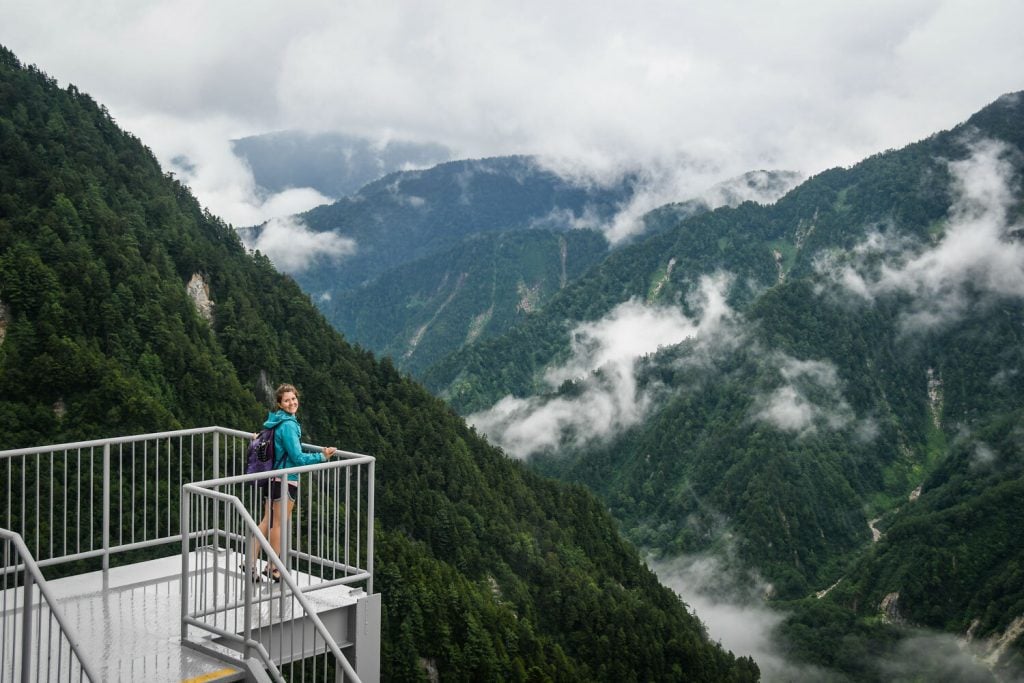
If you love nature, the Tateyama Alpine Route is such a cool experience. You take several modes of transportation to some of the most stunning vistas in the region. It seems popular with Japanese tourists, but we hardly met any other foreign travelers when we did this.
What to pack for Shirakawa-go

What to pack for a visit to Shirakawa-go will depend on the time of year you will be visiting (jump here for our opinion on the best time to visit). Regardless of the season, make sure you bring the following:
- comfortable walking shoes (waterproof is best)
- camera
- sunscreen
- umbrella
Be sure to check out these super helpful guides full of packing hacks and tips for traveling in Japan that you won’t find anywhere else:
- Our Japan packing guide lists all the essentials (many of which you might not think about), as well as what you should NOT pack for a trip to Japan.
- This article on what to wear in Japan will help you create a perfect capsule wardrobe for every season and let you in on some cultural taboos so you can be sure to dress appropriately.
- With this FREE Japan packing list PDF download, we’ll send checklists straight to your inbox for everything from clothing and toiletries (for both women and men!) to what shoes to pack and extra stuff you may want to have on-hand just in case. Click the image below to get your free copy!

Plan your trip to Japan
After 3 trips (and counting!), we’ve fallen head over heels for Japan—and we’ve created TONS of resources to help you plan your dream trip. Start with our Ultimate Japan Travel Guide and be sure to check out these helpful articles:
- First time? Our Japan Trip Planner walks you through everything you need to know.
- Use our Japan Rail Pass guide to determine if getting a train pass is optimal for your trip.
- Here’s our curated list of the best things to do in Japan—from iconic sights to once-in-a-lifetime experiences.
- Not sure where to go? Our Japan itinerary ideas will help you map it all out.
- Foodies, rejoice! This guide to what to eat in Japan will have you drooling before you land.
- This guide to what to wear in Japan (and what not to wear) will help you blend in.
- Use our ultimate Japan Packing List to make sure you don’t forget anything.
- Before you go, brush up on these essential Japan travel tips (including major do’s and don’ts!).
- Avoid awkward moments by brushing up on Japanese etiquette.
Still have questions? Drop us a comment—we LOVE helping travelers plan unforgettable trips to Japan!
Perfect Japan itinerary
Want the perfect itinerary planned for you?

If you don’t have a ton of time to spend planning your Japan itinerary (or you just don’t find travel planning fun), we’ve got something you might be interested in…
We created the ultimate done-for-you Japan itinerary that is packed full of all sorts of tips we’ve gathered from 3 trips to Japan as well as literally hundreds of hours of research (no exaggeration).
We have both an off-the-beaten path route as well as a classic itinerary that hits the top attractions (perfect for your first visit to Japan!).
Don’t miss your chance to grab our Japan packing list!
This FREE PDF download includes everything you’re going to want to pack for your Japan trip, including what NOT to bring, plus tons of insider tips!
Just enter your email and we’ll immediately send you access instructions!
Save this article on Pinterest for later!


We want to hear from you!
Have you ever been to Shirakawa-go? We would love to hear about your experiences, especially if you’ve visited Suganuma or Ainokura!
Are you planning a trip to Shirakawa-go and still have questions? Comment below and we’ll do our best to get back to you!


Could u drop the location pin of the free parking again as the one in the article is not working?